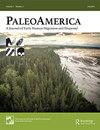Cueva Los Bancos, A New Archaeological Site with Early Occupations in the Southernmost Sector of the Eastern Sierras Pampeanas of Argentina
IF 1.7
Q1 ANTHROPOLOGY
引用次数: 0
Abstract
ABSTRACTWe present new chronological data for the southernmost sector of the Eastern Sierras Pampeanas system of central Argentina. Recent excavations at the Cueva Los Bancos site in Sierra del Morro hill provided a date of ca. 9400 calendar years ago. This is the earliest absolute chronology of this sector, considered an ecotone between mountains and plains. Data provided will allow us to include this site in the discussion of the initial peopling of the region.KEYWORDS: Early Holoceneinitial peoplingecotone landscapeSierras PampeanasSierra del Morro AcknowledgementsThe authors thank the Fernández family for allowing them to enter their property; to Walter Muñoz for guiding them through the landscape; and to Pipera, Dante, Agustín, Eimi, Sol, Valentín and Emilia for collaborating during fieldwork. Also thanks to Gustavo Politis and Laprei (Pretreatment Laboratory for isotopic samples) for managing radiocarbon analyses; to the authorities of the province of San Luis and San José del Morro locality for allowing us to investigate; and to INCUAPA-CONICET for supporting the research and laboratory studies.Disclosure statementNo potential conflict of interest was reported by the author(s).Additional informationFundingThis work was supported by the National Agency for Scientific and Technological Research under Grant PICT 2019-03515.Notes on contributorsRafael CurtoniRafael Curtoni is a researcher for the Argentine National Research Council (CONICET). He obtained his degree at the National University of Buenos Aires and his PhD from the National University of La Plata, Argentina. He also has a MA degree from Institute of Archaeology, University College London. He carries out anthropological and archaeological research in the provinces of La Pampa and San Luis from the perspective of landscape anthropology.Guillermo HeiderGuillermo Heider is a researcher for the Argentine National Research Council (CONICET), and he obtained his degree and PhD from the National University of Córdoba, Argentina. His research interests are lithic technology and human adaptation to arid and semiarid environments through time.Augusto OlivánAugusto Oliván, is a doctoral fellow of the Argentine National Research Council (CONICET), and he obtained his degree at the National University of the Centre of Buenos Aires province, Argentina. He is researching the rock art of the province of San Luis from landscape archaeology and archaeoastronomy.María Clara ÁlvarezMaría Clara Álvarez is a researcher for the Argentine National Research Council (CONICET), and she obtained her degree and PhD from the National University of the Centre of Buenos Aires province. Argentina. Her research focuses on the subsistence of human groups in the past, bone technology, and taphonomic studies.Ivana OzánIvana Ozán is a researcher for the Argentine National Research Council (CONICET), and she obtained her degree of Anthropology and PhD of Archaeology at the University of Buenos Aires, Argentina. She works on past human-environmental interactions by using Soil and Earth Sciences. She has specialized in cave archaeological contexts and rock art painting archaeometry.Julián TobalJulián Tobal is a student of Earth Sciences at the National University of Buenos Aires, Argentina. He is carrying out his undergraduate thesis on the sedimentology and geomorphology of a cave archaeological context. He is interested in environmental studies and climate-social topics.Mariángeles BorgoMariángeles Borgo is a researcher for the Argentine National Research Council (CONICET), and she obtained his degree and PhD from the National University of the Centre of Buenos Aires province, Argentina. She analyzes the technological organization of hunter-gatherer groups in San Luis province.Alfonsina TripaldiAlfonsina Tripaldi is a researcher for the Argentine National Research Council (CONICET), and she obtained her degree in Geology and PhD in Geology at the National University of Buenos Aires, Argentina. She works on landscape evolution during the late Quaternary, mainly in drylands, applying geomorphology and sedimentology and associating with paleoecologists and archaeologists to explore past human-environmental interactions.Cueva Los Bancos,一个新的考古遗址,在阿根廷东部山脉最南端的早期活动
摘要:我们提出了阿根廷中部东部山脉系统最南端的新年代学数据。最近在Sierra del Morro山的Cueva Los Bancos遗址的挖掘提供了大约9400日历年前的日期。这是该地区最早的绝对年表,被认为是山脉和平原之间的过渡带。所提供的数据将使我们能够将该地点纳入对该地区最初人口的讨论。关键词:全新世早期人类早期迁移过渡带景观ierras pampeanasassierra del Morro致谢作者感谢Fernández家族允许他们进入他们的财产;沃尔特Muñoz引导他们穿越风景;以及Pipera, Dante, Agustín, Eimi, Sol, Valentín和Emilia在野外工作中的合作。还要感谢Gustavo Politis和Laprei(同位素样品预处理实验室)对放射性碳分析的管理;感谢圣路易斯省和圣何塞德尔莫罗地方当局允许我们进行调查;以及INCUAPA-CONICET对研究和实验室研究的支持。披露声明作者未报告潜在的利益冲突。本研究得到了国家科学技术研究局PICT 2019-03515拨款的支持。作者简介:irafel Curtoni是阿根廷国家研究委员会(CONICET)的研究员。他在布宜诺斯艾利斯国立大学获得学位,在阿根廷拉普拉塔国立大学获得博士学位。他还拥有伦敦大学学院考古研究所的硕士学位。他从景观人类学的角度在拉潘帕省和圣路易斯省开展人类学和考古学研究。Guillermo Heider,阿根廷国家研究委员会(CONICET)研究员,获得阿根廷国立大学Córdoba学位和博士学位。他的研究兴趣是石器技术和人类对干旱和半干旱环境的适应。奥古斯托OlivánAugusto Oliván,阿根廷国家研究委员会(CONICET)博士研究员,毕业于阿根廷布宜诺斯艾利斯省中心国立大学。他正在从景观考古学和考古天文学的角度研究圣路易斯省的岩石艺术。María Clara ÁlvarezMaría Clara Álvarez是阿根廷国家研究委员会(CONICET)的研究员,她在布宜诺斯艾利斯省中心国立大学获得学位和博士学位。阿根廷。她的研究主要集中在过去人类群体的生存、骨骼技术和埋藏学研究。Ivana OzánIvana Ozán是阿根廷国家研究委员会(CONICET)的研究员,她在阿根廷布宜诺斯艾利斯大学获得人类学学位和考古学博士学位。她利用土壤和地球科学研究过去人类与环境的相互作用。她专门研究洞穴考古背景和岩石艺术绘画考古。Julián TobalJulián Tobal是阿根廷布宜诺斯艾利斯国立大学地球科学专业的一名学生。他正在进行关于洞穴考古背景下的沉积学和地貌学的本科论文。他对环境研究和气候社会话题感兴趣。Mariángeles BorgoMariángeles Borgo是阿根廷国家研究委员会(CONICET)的研究员,她在阿根廷布宜诺斯艾利斯省中心国立大学获得学位和博士学位。她分析了圣路易斯省狩猎采集者群体的技术组织。Alfonsina Tripaldi是阿根廷国家研究委员会(CONICET)的研究员,她在阿根廷布宜诺斯艾利斯国立大学获得地质学学位和地质学博士学位。她主要在旱地研究晚第四纪的景观演变,运用地貌学和沉积学,并与古生态学家和考古学家合作,探索过去人类与环境的相互作用。
本文章由计算机程序翻译,如有差异,请以英文原文为准。
求助全文
约1分钟内获得全文
求助全文
来源期刊

PaleoAmerica
Earth and Planetary Sciences-Paleontology
CiteScore
3.70
自引率
0.00%
发文量
15
期刊介绍:
PaleoAmerica disseminates new research results and ideas about early human dispersal and migrations, with a particular focus on the Americas. It fosters an interdisciplinary dialog between archaeologists, geneticists and other scientists investigating the dispersal of modern humans during the late Pleistocene. The journal has three goals: First and foremost, the journal is a vehicle for the presentation of new research results. Second, it includes editorials on special topics written by leaders in the field. Third, the journal solicits essays covering current debates in the field, the state of research in relevant disciplines, and summaries of new research findings in a particular region, for example Beringia, the Eastern Seaboard or the Southern Cone of South America. Although the journal’s focus is the peopling of the Americas, editorials and research essays also highlight the investigation of early human colonization of empty lands in other areas of the world. As techniques are developing so rapidly, work in other regions can be very relevant to the Americas, so the journal will publish research relating to other regions which has relevance to research on the Americas.
 求助内容:
求助内容: 应助结果提醒方式:
应助结果提醒方式:


